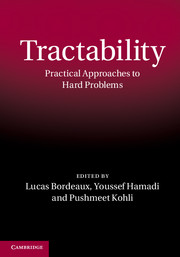Book contents
- Frontmatter
- Contents
- Contributors
- Introduction
- Part 1 Graphical Structure
- Part 2 Language Restrictions
- 3 Submodular Function Maximization
- 4 Tractable Valued Constraints
- 5 Tractable Knowledge Representation Formalisms
- Part 3 Algorithms and their Analysis
- Part 4 Tractability in Some Specific Areas
- Part 5 Heuristics
4 - Tractable Valued Constraints
from Part 2 - Language Restrictions
Published online by Cambridge University Press: 05 February 2014
- Frontmatter
- Contents
- Contributors
- Introduction
- Part 1 Graphical Structure
- Part 2 Language Restrictions
- 3 Submodular Function Maximization
- 4 Tractable Valued Constraints
- 5 Tractable Knowledge Representation Formalisms
- Part 3 Algorithms and their Analysis
- Part 4 Tractability in Some Specific Areas
- Part 5 Heuristics
Summary
In this chapter, we will survey recent results on the broad family of optimisation problems that can be cast as valued constraint satisfaction problems (VCSPs). We discuss general methods for analysing the complexity of such problems, and give examples of tractable cases.
Introduction
Computational problems from many different areas involve finding values for variables that satisfy certain specified restrictions and optimise certain specified criteria.
In this chapter, we will show that it is useful to abstract the general form of such problems to obtain a single generic framework. Bringing all such problems into a common framework draws attention to common aspects that they all share, and allows very general analytical approaches to be developed. We will survey some of these approaches, and the results that have been obtained by using them.
The generic framework we shall use is the valued constraint satisfaction problem (VCSP), defined formally in Section 4.3. We will show that many combinatorial optimisation problems can be conveniently expressed in this framework, and we will focus on finding restrictions to the general problem which are sufficient to ensure tractability.
An important and well-studied special case of the VCSP is the constraint satisfaction problem (CSP), which deals with combinatorial search problems which have no optimisation criteria. We give a brief introduction to the CSP in Section 4.2, before defining the more general VCSP framework in Section 4.3. Section 4.4 then presents a number of examples of problems that can be seen as special cases of the VCSP.
The remainder of the chapter discusses what happens to the complexity of the valued constraint satisfaction problem when we restrict it in various ways.
Information
- Type
- Chapter
- Information
- TractabilityPractical Approaches to Hard Problems, pp. 105 - 140Publisher: Cambridge University PressPrint publication year: 2014
Accessibility standard: Unknown
- 1
- Cited by
